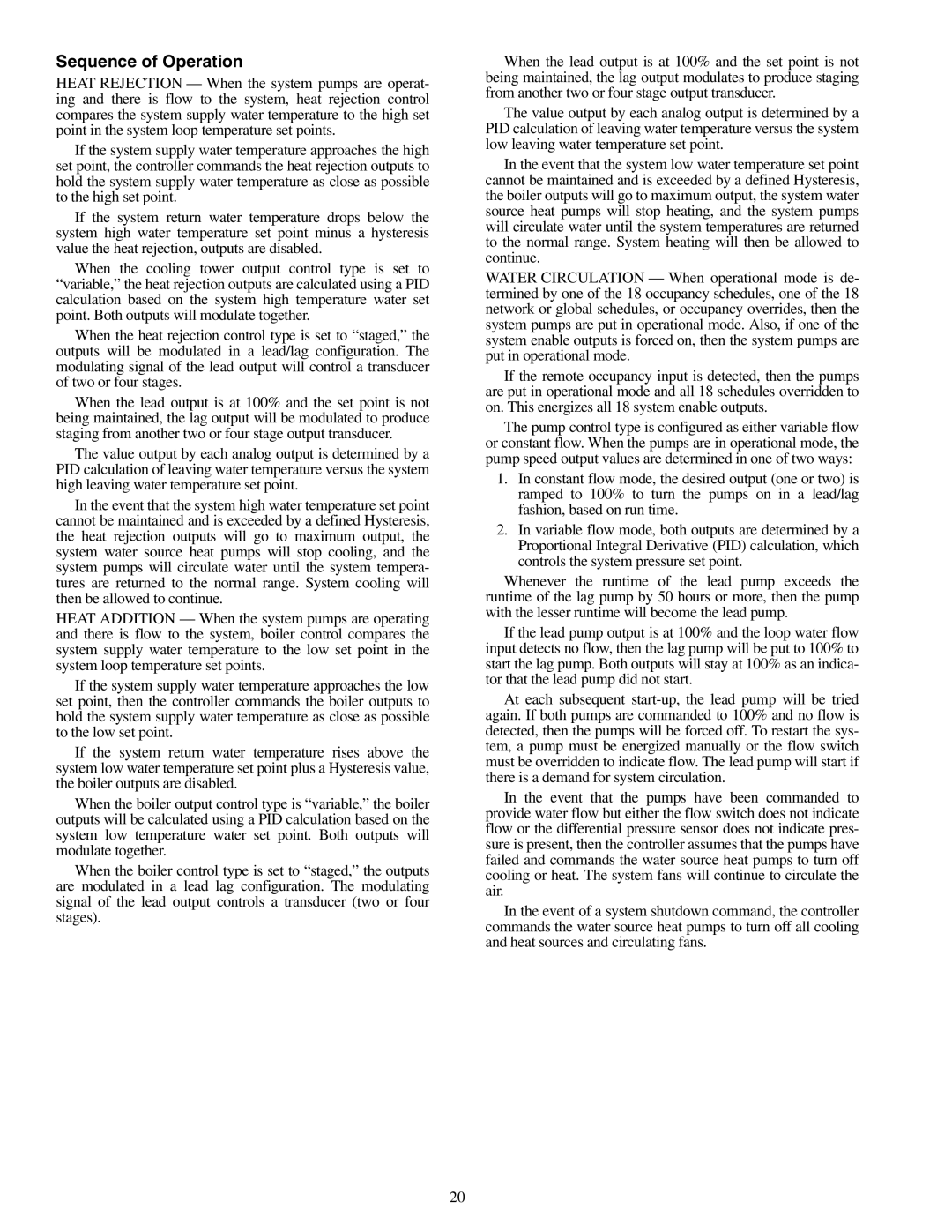Sequence of Operation
HEAT REJECTION — When the system pumps are operat- ing and there is flow to the system, heat rejection control compares the system supply water temperature to the high set point in the system loop temperature set points.
If the system supply water temperature approaches the high set point, the controller commands the heat rejection outputs to hold the system supply water temperature as close as possible to the high set point.
If the system return water temperature drops below the system high water temperature set point minus a hysteresis value the heat rejection, outputs are disabled.
When the cooling tower output control type is set to “variable,” the heat rejection outputs are calculated using a PID calculation based on the system high temperature water set point. Both outputs will modulate together.
When the heat rejection control type is set to “staged,” the outputs will be modulated in a lead/lag configuration. The modulating signal of the lead output will control a transducer of two or four stages.
When the lead output is at 100% and the set point is not being maintained, the lag output will be modulated to produce staging from another two or four stage output transducer.
The value output by each analog output is determined by a PID calculation of leaving water temperature versus the system high leaving water temperature set point.
In the event that the system high water temperature set point cannot be maintained and is exceeded by a defined Hysteresis, the heat rejection outputs will go to maximum output, the system water source heat pumps will stop cooling, and the system pumps will circulate water until the system tempera- tures are returned to the normal range. System cooling will then be allowed to continue.
HEAT ADDITION — When the system pumps are operating and there is flow to the system, boiler control compares the system supply water temperature to the low set point in the system loop temperature set points.
If the system supply water temperature approaches the low set point, then the controller commands the boiler outputs to hold the system supply water temperature as close as possible to the low set point.
If the system return water temperature rises above the system low water temperature set point plus a Hysteresis value, the boiler outputs are disabled.
When the boiler output control type is “variable,” the boiler outputs will be calculated using a PID calculation based on the system low temperature water set point. Both outputs will modulate together.
When the boiler control type is set to “staged,” the outputs are modulated in a lead lag configuration. The modulating signal of the lead output controls a transducer (two or four stages).
When the lead output is at 100% and the set point is not being maintained, the lag output modulates to produce staging from another two or four stage output transducer.
The value output by each analog output is determined by a PID calculation of leaving water temperature versus the system low leaving water temperature set point.
In the event that the system low water temperature set point cannot be maintained and is exceeded by a defined Hysteresis, the boiler outputs will go to maximum output, the system water source heat pumps will stop heating, and the system pumps will circulate water until the system temperatures are returned to the normal range. System heating will then be allowed to continue.
WATER CIRCULATION — When operational mode is de- termined by one of the 18 occupancy schedules, one of the 18 network or global schedules, or occupancy overrides, then the system pumps are put in operational mode. Also, if one of the system enable outputs is forced on, then the system pumps are put in operational mode.
If the remote occupancy input is detected, then the pumps are put in operational mode and all 18 schedules overridden to on. This energizes all 18 system enable outputs.
The pump control type is configured as either variable flow or constant flow. When the pumps are in operational mode, the pump speed output values are determined in one of two ways:
1.In constant flow mode, the desired output (one or two) is ramped to 100% to turn the pumps on in a lead/lag fashion, based on run time.
2.In variable flow mode, both outputs are determined by a Proportional Integral Derivative (PID) calculation, which controls the system pressure set point.
Whenever the runtime of the lead pump exceeds the runtime of the lag pump by 50 hours or more, then the pump with the lesser runtime will become the lead pump.
If the lead pump output is at 100% and the loop water flow input detects no flow, then the lag pump will be put to 100% to start the lag pump. Both outputs will stay at 100% as an indica- tor that the lead pump did not start.
At each subsequent start-up, the lead pump will be tried again. If both pumps are commanded to 100% and no flow is detected, then the pumps will be forced off. To restart the sys- tem, a pump must be energized manually or the flow switch must be overridden to indicate flow. The lead pump will start if there is a demand for system circulation.
In the event that the pumps have been commanded to provide water flow but either the flow switch does not indicate flow or the differential pressure sensor does not indicate pres- sure is present, then the controller assumes that the pumps have failed and commands the water source heat pumps to turn off cooling or heat. The system fans will continue to circulate the air.
In the event of a system shutdown command, the controller commands the water source heat pumps to turn off all cooling and heat sources and circulating fans.
